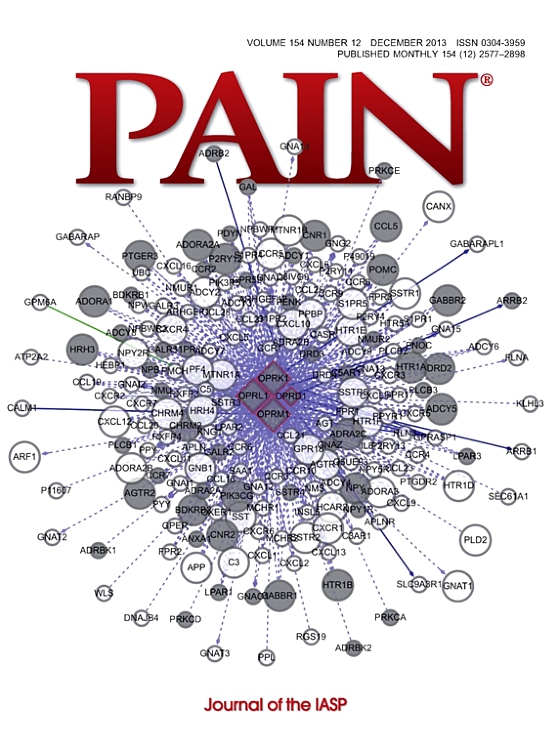慢性疼痛与睡眠呼吸暂停严重程度有关,但在使用阿片类药物的人群中,间歇性低氧血症会减轻疼痛。
IF 5.5
1区 医学
Q1 ANESTHESIOLOGY
引用次数: 0
摘要
长期使用阿片类药物治疗疼痛的患者往往症状不受控制,这可能会推动阿片类药物的持续使用,并导致阿片类药物公共卫生危机。阿片类药物还会导致睡眠呼吸障碍(SDB),这可能会通过唤醒和低氧血症影响疼痛,有可能形成恶性循环。研究招募了每天使用阿片类药物治疗非癌性疼痛的成年人,持续50 ~ 3个月。受试者接受疼痛和睡眠问卷调查,通过10°C冷压测试进行疼痛耐受性测试,并进行多导睡眠描记。缺氧负荷由多导睡眠图信号分析确定。参与者(n = 143)的年龄中位数(四分位数范围)为60(51,67)岁,体重指数29 (25,35)kg/m2。80例(56%)为女性。中位每日吗啡当量剂量为20(10,45)。78%的患者呼吸暂停低通气指数(AHI)为bb0.5 /小时,41%的患者AHI为>15/小时。PROMIS疼痛干扰评分在SDB严重程度上存在差异,轻度和中度SDB的症状增加,但严重SDB的症状没有增加。随着AHI的增加,疼痛加重(β = 2.2[95%可信区间[CI]: 0.08, 4.4];βstd = 1.3;P = 0.043),但这种关系在高水平的缺氧负荷下减弱(每相互作用;β = -0.42 [95% ci: -0.78, -0.06];βstd = -0.85;P = 0.023)。在冷压试验中,随着AHI的增加,手停药的时间缩短(风险比[HR] 2.60 [95% CI: 1.48, 4.57];P = 0.001),但在较高的缺氧负荷下也会减弱(风险比:0.86 [95% CI: 0.78, 0.94];P = 0.002)。总体而言,SDB与使用阿片类药物治疗慢性疼痛的患者疼痛加重有关,但低氧血症减弱了这种影响。具有相同AHI的个体根据缺氧负荷可能有不同的症状。介入研究将有助于阐明SDB治疗在疼痛管理中的机制和作用。本文章由计算机程序翻译,如有差异,请以英文原文为准。
Chronic pain is associated with sleep apnea severity but attenuated by intermittent hypoxemia in people using opioids.
Patients using long-term opioids for pain often have uncontrolled symptoms which might drive ongoing opioid use and contribute to the opioid public health crisis. Opioids also cause sleep disordered breathing (SDB), which might impact pain via arousals and hypoxemia, with potential for a vicious cycle. Adults with noncancer pain using opioids daily for >3 months were recruited. Subjects underwent pain and sleep questionnaires, pain tolerance via 10°C cold pressor testing, and polysomnography. Hypoxic burden was determined from polysomnographic signal analysis. Participants (n = 143) had a median (interquartile range) age of 60 (51, 67) years, body mass index 29 (25, 35) kg/m2. 80 (56%) subjects were female. The median daily morphine equivalent dose was 20 (10, 45). 78% had an apnea-hypopnea index (AHI) >5/hour and 41% with AHI >15/hour. PROMIS pain interference scores differed across SDB severity, with increased symptoms in mild and moderate but not severe SDB. With increasing AHI, there was worsened pain (β = 2.2 [95% confidence interval [CI]: 0.08, 4.4]; βstd = 1.3; P = 0.043), but this relationship was attenuated at higher levels of hypoxic burden (per interaction; β = -0.42 [95% CI: -0.78, -0.06]; βstd = -0.85; P = 0.023). During cold pressor testing, there was a reduced time to hand withdrawal with increasing AHI (hazard ratio [HR] 2.60 [95% CI: 1.48, 4.57]; P = 0.001), but this was also attenuated at higher hypoxic burden (HR: 0.86 [95% CI: 0.78, 0.94]; P = 0.002). Overall, SDB is linked with worsened pain in those using opioids for chronic pain, but hypoxemia attenuates the effect. Individuals with the same AHI may have different symptoms depending on hypoxic burden. Interventional studies will help elucidate mechanisms and the role for SDB treatment in pain management.
求助全文
通过发布文献求助,成功后即可免费获取论文全文。
去求助
来源期刊

PAIN®
医学-临床神经学
CiteScore
12.50
自引率
8.10%
发文量
242
审稿时长
9 months
期刊介绍:
PAIN® is the official publication of the International Association for the Study of Pain and publishes original research on the nature,mechanisms and treatment of pain.PAIN® provides a forum for the dissemination of research in the basic and clinical sciences of multidisciplinary interest.
 求助内容:
求助内容: 应助结果提醒方式:
应助结果提醒方式:


